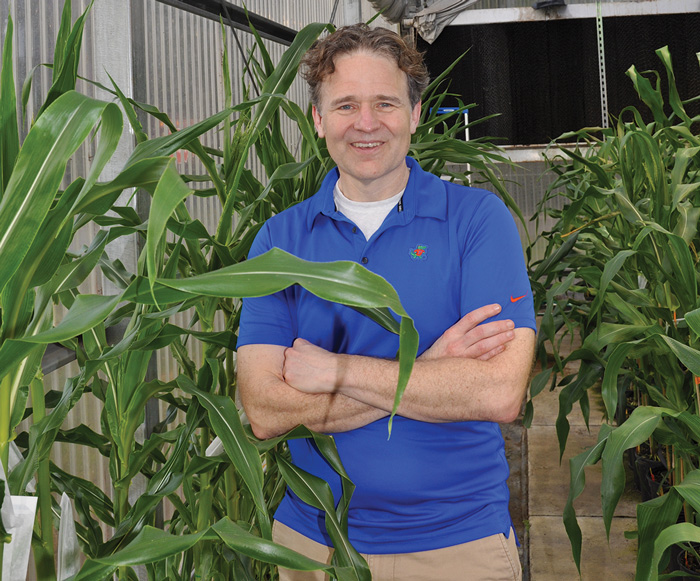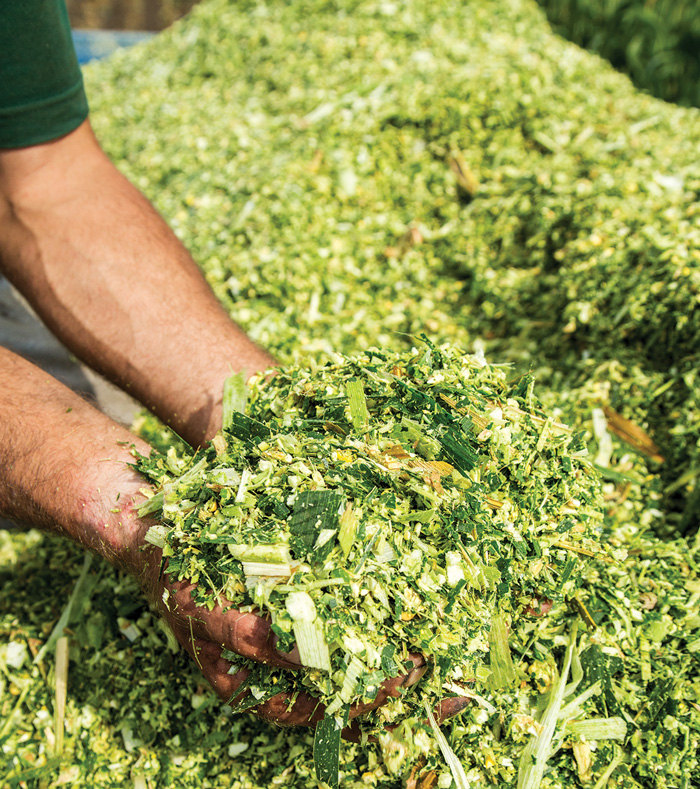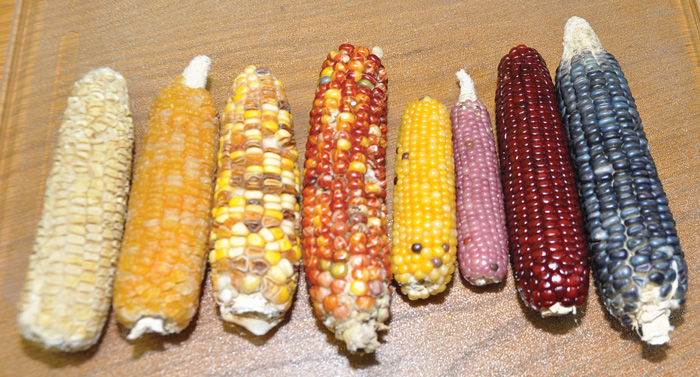
The Sweet State of Corn
Researchers at the University of Florida are on a mission to save—and sweeten—sweet corn.
Article Content
Driving through the Midwest, one could easily assume Illinois, Indiana, Iowa, Kansas, Nebraska, and the rest of the Corn Belt are the growing regions for the deliciously sweet ears of corn served at barbecues and picnics and on dinner plates across America. That assumption is wrong. The corn in the Corn Belt is field corn; the corn on Americans’ plates is sweet corn, and according to the Green Giant, it is the second most popular vegetable in America. Sweet corn is available fresh, frozen, and canned, but fresh market sweet corn accounts for more than 70% of the value of the sweet corn market. Florida is the biggest producer of fresh-market sweet corn in America; its sweet corn crops constitute a $150 million industry. But according to the U.S. Department of Agriculture (USDA), the consumption of sweet corn is down. “Sweet corn has traditionally been a really popular vegetable in the [United States], but it’s getting hit harder in terms of the decline [in vegetable consumption]. Americans are eating less and less vegetables every year, and one of the vegetables they’re dropping the fastest is sweet corn,” says A. Mark Settles, a professor in the Department of Horticultural Sciences at the University of Florida—the lead institution in a multidisciplinary effort to improve the genetic foundation of sweet corn.
Settles is the director of the sweet corn coordinated agricultural project, which is funded by the USDA. The purpose of the project is to develop genomic and breeding resources to improve the genetic foundation of sweet corn. The project’s objective is to maintain the sweetness and other optimal sensory qualities of sweet corn while improving its resistance to pests and pathogens and increasing its yield. Besides the University of Florida, the University of Wisconsin–Madison, Iowa State University, Washington State University, and the USDA’s Agricultural Research Service field office in Florida are also working on this project. “The locations of these institutions are based on where sweet corn is really heavily produced. Florida and Georgia make up about 25% to 30% of the fresh market sweet corn for the whole country. Florida’s producing sweet corn for all that early season stuff that you see,” Settles says. “Wisconsin and the Pacific Northwest (Oregon and Washington) produce the vast majority of processing corn (canned corn, frozen corn, etc.).” Moreover, each institution provides a specialized area of expertise to the project because maintaining the taste and texture of sweet corn while improving its resistance and yield is not an easy undertaking.
A Very Special Kernel
There are six major types of corn: 1) dent corn, 2) flint corn, 3) flour corn, 4) pod corn, 5) popcorn, and 6) sweet corn. Most of the corn growing in fields across the United States is dent corn, which is also called field corn. “Field corn is predominantly used for animal feeds. Field corn and soybeans combined are used to provide protein and starch to feed out chickens, pigs, and cows,” Settles says. “It’s also for ethanol production (for biofuels) and as chemical substrates for manufacturing. Corn starch can wind up in things like diapers and other kinds of materials that you wouldn’t necessarily think it was being used for.” Field corn is also used to make certain food products, such as corn syrup, corn flakes, corn meal, corn chips, and corn tortillas as well as silage. “Silage is something that [farmers] feed to animals like cows in the winter as a way to give them, essentially, a pickled-cabbage substitute for fresh grass that farmers would normally have them eating in the summer,” Settles says. Sweet corn and popcorn round out the three types of corn mostly grown in the United States.
Among all the types of corn, sweet corn is rather unique: Whether yellow, white, or bicolored, all varieties of sweet corn are the result of natural mutations of corn genes that code for starch; these mutations cause sweet corn to have a sugar content that is twice that of field corn and less starch. “What makes sweet corn sweet corn is that it has one to two recessive mutations,” Settles explains. “Recessive mutations are ones where you have to have two copies of the mutant and be homozygous for you to see the sweet corn phenotype. What that means is that breeders always keep breeding within a sweet corn. They breed within the sweet corn population.” This means that field corn, popcorn, and other types of corn never get crossed with sweet corn. Because sweet corn is always being inbred, it misses out on genes in other types of corn that confer beneficial characteristics such as resistance to certain plant pathogens and pests. “There’s a whole bunch of disease-resistance alleles, there’s a whole bunch of insect-resistance alleles, [and] there’s a whole bunch of drought tolerance that’s out there in the natural populations of corn that sweet corn breeders don’t really have access to,” Settles says.
Breeding for Better
The Settles laboratory is therefore investigating a variety of breeding techniques and technologies to endow sweet corn with favorable characteristics. Most of the focus of his laboratory and others participating in the sweet corn coordinated agricultural project is on developing better conventional breeding techniques to improve sweet corn. Settles and his staff are determining phenotyping technologies that will allow farmers and breeders to predict the characteristics a mature corn plant will have based on the phenotype of a sweet corn kernel and to breed sweet corn lines faster. They are also trying to introduce double haploid technology to sweet corn breeders. Double haploid technology “is something that’s used in field corn a lot but hasn’t really been used in sweet corn,” Settles reveals. “It is a fast-forward breeding approach; basically, it cuts about four years out of the breeding cycle. That allows breeders to make faster progress towards improved corn. We’re trying to get that technology put together, and my lab is working closely with the Iowa State lab to do that particular part of the project.” The project’s researchers are also relying on gene editing tools to speed up the identification of specific genes. “We do have some experimental things using both gene editing and a couple of things [using] biotechnology (i.e., making genetically modified organisms). The reason for that is to see whether or not we can get traits that might be desirable and, once we figure those out, how would we then get those same traits conventionally,” Settles says.
At the end of the sweet corn coordinated agricultural project, Settles hopes to have created sweet corn genotypes that imbue sweet corn with more resistance, higher yield, and cold tolerance while still maintaining the sweet corn traits that people universally prefer. This will involve crossing varieties of field corn with sweet corn because field corn has resistance and other properties that sweet corn doesn’t. However, breeders would then have to make sure that the result looks and tastes like sweet corn. “What we’re hoping to do is [provide] breeders with a better toolbox to be able to quickly breed between different types of corn and also a set of genes identified or markers that are associated with the things that you need to have [for] good quality sweet corn,” Settles says. Charles Sims, a professor in the Department of Food Science and Human Nutrition at the University of Florida, is the sensory expert in charge of helping breeders determine the sensory qualities that are most important in sweet corn. “My role is to measure how much consumers like sweet corn and what do they think about certain characteristics: … what consumers want or what consumers like and don’t like and then feed that back to the geneticists and plant breeders,” Sims says.
Sweet Corn Has Standards
As the head of the University of Florida’s sensory analysis and sensory testing program, Sims knows what the best tool is for sensory analysis: “A human is the ultimate instrument in measuring how much we like things and the sensory characteristics of foods. There’s no machine that can duplicate what happens in your mouth and your nose and your brain,” he says. “We have to use humans to be able to predict which foods are more acceptable, which foods are sweeter, [and] which foods have certain characteristics associated with them. It’s actually important not only in plant breeding, which we’re involved with now, but also in the food industry.” The sensory work is very important because the project will not be a success if the agricultural properties of sweet corn are vastly improved, but consumers won’t eat it. “If you make a corn that’s more disease-resistant, does it taste worse?” Sims considers. “When [breeders] alter a plant variety for some other reason, does it affect consumer acceptability? We want to develop the best corn varieties possible in all different ways and still have good consumer acceptability. … If corn has better consumer acceptability, everybody hopes—at least in the corn community—it will lead to increased corn consumption.”
Consumers often use the terms “taste” and “flavor” as if they were synonymous, but they actually have distinct meanings. There are five universally accepted basic tastes: sweet, sour, salty, bitter, and umami. “Retronasal olfaction is basically the main contributor for flavor. The way that you can cut that off is you can plug your nose. If you plug your nose and stop the airflow, these volatiles can’t get up to your olfactory receptors,” Sims explains. “The basic tastes (sweet, salty, bitter, etc.) are what your tongue detects.” The most significant factor in consumer acceptability of sweet corn is sweet. “Consumers love sweet in any capacity, and that includes sweet corn. We’ve learned to associate good quality corn with sweetness—whether that’s canned corn or frozen corn or fresh corn. … People don’t eat much field corn because it’s just starchy and it’s not very sweet,” Sims asserts. “We’ve learned to like and appreciate corn that’s sweet; the sweeter the better, in general. There’s probably a maximum level: You could probably get sweet corn that’s too sweet, but we’re not at that point yet.” Most sensory testing is done via the nine-point hedonic scale. This scale was developed to measure the food preferences of U.S. military soldiers and was adopted by the food industry. However, Sims and his sensory staff do not use this scale to conduct most of their sensory testing. Instead, the sensory staff developed a proprietary scale to test consumers’ liking and acceptability of various foods. “We use a scale … that’s pretty unique. It’s not like the nine-point hedonic scale, so it’s not real intuitive to use.”
Taste and flavor are significant sensory cues in sweet corn acceptance, but appearance and texture also contribute to sensory analysis. In general, most consumers expect for the husks of sweet corn to be green and its silks to be yellow or green. “There’s a lot of variation that doesn’t actually relate to how fresh the corn is: There are husk leaves that will look dull gray, and it’s still perfectly fresh and nice sweet corn, but nobody is going to buy that on the market,” Settles says. “There’s a lot of corns that have pink and brown [silks] naturally while they’re fresh, but you can’t have that because people will think there’s something wrong with it.” Genetics control all the characteristics of plants: crop yield, disease resistance, taste, flavor, and texture. “All the characteristics that consumers appreciate come from the genetics of the plant. The more we know about genetics, the more we can potentially manipulate genes to get better corn,” Sims says. The researchers of the sweet corn coordinated agricultural project have sequenced the sweet corn genome and are in the process of evaluating all varieties of sweet corn and sequencing their DNA. “We’ll be able to associate [sweet corn’s] genetic polymorphisms with their specific traits. The breeders will then be able to mine that data and find, [for example,] an inbred line that has a trait that they’re interested in and what are the genes and alleles that are most correlated with that favorable trait,” Settles concludes. “It’s not necessarily that we want to make it sweeter at harvest as much as we want it to have good shelf life so that it’s a nice product that you would really enjoy eating at harvest, and then one week later when you actually get it in the grocery store, it’s still a nice product that you would like to eat.”
And what person wouldn’t want delicious fresh market sweet corn year-round? Surely even the Green Giant would approve.










